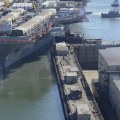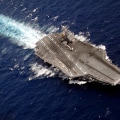The world of nuclear-powered ships is an intriguing one, with more than 160 vessels running on over 200 small nuclear reactors. From submarines to aircraft carriers, these vessels are powered by heat generated from nuclear reactors. In the future, restrictions on the use of fossil fuels in transportation may cause marine nuclear propulsion to become more widespread. Nuclear propulsion is mainly used in naval warships, such as nuclear submarines and supercarriers.
A small number of experimental civilian nuclear craft have also been built. Nuclear power is particularly suitable for ships, which need to be at sea for long periods without refueling, or for powerful underwater propulsion. Today, more than 150 ships are powered by small nuclear reactors. The United States Navy operates about 100 nuclear vessels, and six nations currently operate nuclear-powered ships.
Most of these are submarines, but they range in type from icebreakers to aircraft carriers. Russia is the only country that operates nuclear-powered civilian ships, all but one of them icebreakers. Brazil has a nuclear submarine program, but has not yet produced an operational submarine. The American Bureau of Shipping (ABS) has announced the launch of a research project that will analyze barriers to the adoption of advanced nuclear propulsion for commercial ships.
In the early days of nuclear energy development, a wide range of nuclear technologies and applications were explored. With the increasing attention paid to greenhouse gas emissions from the burning of fossil fuels for international air and sea transport and the excellent safety record of nuclear-powered vessels, it is quite conceivable that renewed attention will be paid to marine nuclear propulsion. The first nuclear-powered submarine, the USS Nautilus, went to sea in 1955, marking the transition from slow submarines to warships capable of withstanding between 20 and 25 knots, submerged for weeks. Discharges of rare earth elements formed as fission products by thermal neutrons during nuclear power production are not as well studied. Russia built 248 nuclear submarines and five surface naval vessels powered by 468 reactors between 1950 and 2003. The technology was shared with Great Britain; the development of nuclear-powered ships in France, the former Soviet Union and China was developed separately. The studies made several assumptions that nuclear propulsion was disadvantaged: operating profiles resulted in a capacity factor of less than 30 percent, no emissions cost was assumed, and a military ship that saves space and weight by replacing thousands of tons of fuel storage does not increase its revenue potential by being able to deliver more cargo per trip. Thousands and thousands of people have lived, worked, eaten and slept a stone's throw from these nuclear reactors for 60 years without any adverse effects of radiation. Unlike land-based applications where hundreds of acres can be occupied by facilities such as the Bruce Nuclear Power Plant, tight space limits dictate that a marine reactor must be physically small, so it must generate more power per unit of space. But there are another hundred nuclear reactors that power 86 submarines and aircraft carriers, producing electricity, heat and propulsion.
Nuclear reactor compartments are trimmed, carefully sealed and taken to an approved disposal site. In conclusion, it is clear that marine nuclear propulsion is an important part of our world today. With restrictions on fossil fuels becoming more common in transportation, it is likely that this technology will become even more widespread in the future.



